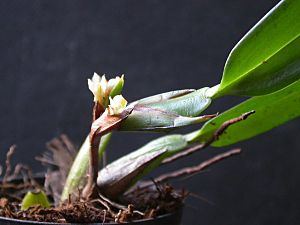Camaridium vestitum facts for kids
Quick facts for kids Purple tiger orchid |
|
|---|---|
 |
|
| Scientific classification | |
| Kingdom: | |
| (unranked): | |
| (unranked): | |
| Order: | |
| Family: | |
| Subfamily: | |
| Tribe: |
Maxillarieae
|
| Subtribe: |
Maxillariinae
|
| Genus: |
Camaridium
|
| Species: |
C. vestitum
|
| Binomial name | |
| Camaridium vestitum (Sw.) Lindl.
|
|
| Synonyms | |
|
|
The Purple tiger orchid (scientific name: Camaridium vestitum) is a beautiful type of orchid. It is known for growing on other plants, like trees, without harming them. This kind of plant is called an epiphytic orchid. You can find this special flower in warm places. These include Florida in the United States, islands in the West Indies, and many countries in Latin America. Its range stretches all the way from Mexico down to Bolivia.
What is the Purple Tiger Orchid?
This orchid, Camaridium vestitum, is an epiphytic plant. This means it grows on other plants, usually trees. It uses them for support, but it doesn't take nutrients from them. Instead, it gets its food and water from the air and rain. Orchids are a very diverse family of flowering plants. They are famous for their unique and often colorful blooms.
Where Does It Live?
The purple tiger orchid loves tropical and subtropical climates. It is native to a wide area. This includes the southern part of Florida. It also grows across the Caribbean islands. You can find it in countries like Mexico and those in Central America. Its habitat extends south into many parts of South America, reaching as far as Bolivia. These areas provide the warm, humid conditions it needs to thrive.
Why Did Its Name Change?
For a long time, this orchid was known as Maxillaria parviflora. This name was even used in important plant guides. However, scientists are always learning new things. They use special studies, like looking at the plant's DNA. These "molecular studies" help them understand how plants are related.
These studies showed that the Maxillaria group of orchids was too big. It needed to be split into several smaller groups. Because of this, many species, including the purple tiger orchid, got new scientific names. This helps scientists classify plants more accurately. It also shows how different plant families are connected.

